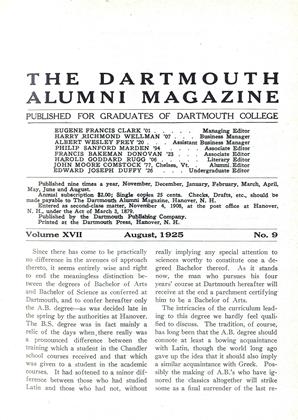In connection with his studies on the evolution of vertebrates which he has been conducting for many years Professor Patten will spend part of the summer in further investigations in Spitzbergen. He. states the object of his researches as follows :
"The key to the problem, which has always been one of the outstanding problems of animal evolution, is probably to be found in the structure of an extinct and little known class of animals called the Ostracoderms. They stand about half way up the: scale of animal life and appear to have been the ancestors of all the backboned animals from fishes up to man. There were many different kinds quite unlike any living animals and most of them are in a very fragmentary condition for they are among the oldest known fossils. Their genetic relation to the lower animals is unknown but on that knowledge depends our understanding of some of the most important organs and functions of the human body. Norwegian and Swedish expeditions have recently discovered in the northwest corner of Spitzbergen some representatives of this ancient class of animals that were in a very remarkable state of preservation, especially as regards such important structures as brain, nerves, jaws, and sense organs. They are now in various Scandinavian jmuseums and are being prepared for a full scientific description."
Dr. Patten plans to spend the summer in the study of these remains and is making a preliminary survey of the conditions in Spitzbergen where they were found. If it seems feasible he will then try to organize an expedition on a larger scale next year in order to excavate and prepare some of the material for American students and institutions. It is possible that other material of this kind may be found of equal importance to science. After preliminary studies in the Scandinavian museums Dr. Patten will land at Ice Fjord in Spitzbergen from whence he will proceed by sealing sloop one hundred and fifty miles up the coast to Red Bay at the northern end of the island where the fossils in question have already been found. This is at a point about sixty miles beyond Queens Bay from which the Amundsen expedition set out for the North Pole.
 View Full Issue
View Full Issue
More From This Issue
-
 Article
ArticleSince There Has Come To Be Practically
August 1925 -
 Article
ArticleSTUDENT FINANCES AT DARTMOUTH
August 1925 By Elwood T. Dickinson, 1924 -
 Class Notes
Class NotesClass of 1903
August 1925 By Perley E. Whelden -
 Article
ArticleCOMMENCEMENT 1925
August 1925 By Natt W. Emerson '00 -
 Article
ArticleJUNE MEETING OF ALUMNI COUNCIL
August 1925 -
 Class Notes
Class NotesClass of 1912
August 1925 By Alvaro M. Garcia
Article
-
 Article
ArticleMILITARY NEWS
April 1919 -
 Article
ArticleFRESHMEN SUCCEED IN TAKING CLASS PICTURE
June, 1923 -
 Article
ArticleThe Annual Meeting of the Secretaries Association
June 1929 -
 Article
Article4.0 Is Only Good
June 1952 By C. E. W. -
 Article
ArticleThayer School News
March 1938 By Edward S. Brown Jr -
 Article
ArticleTwenty-Five Years Ago
February 1935 By Hap Hinman '10


